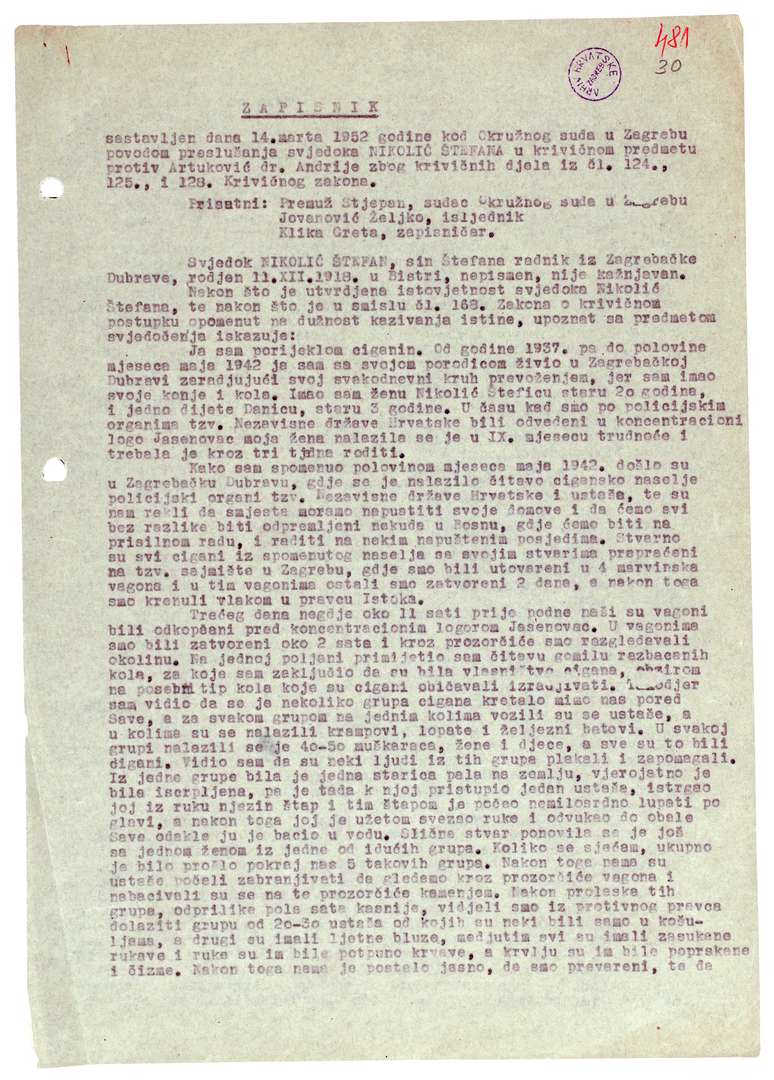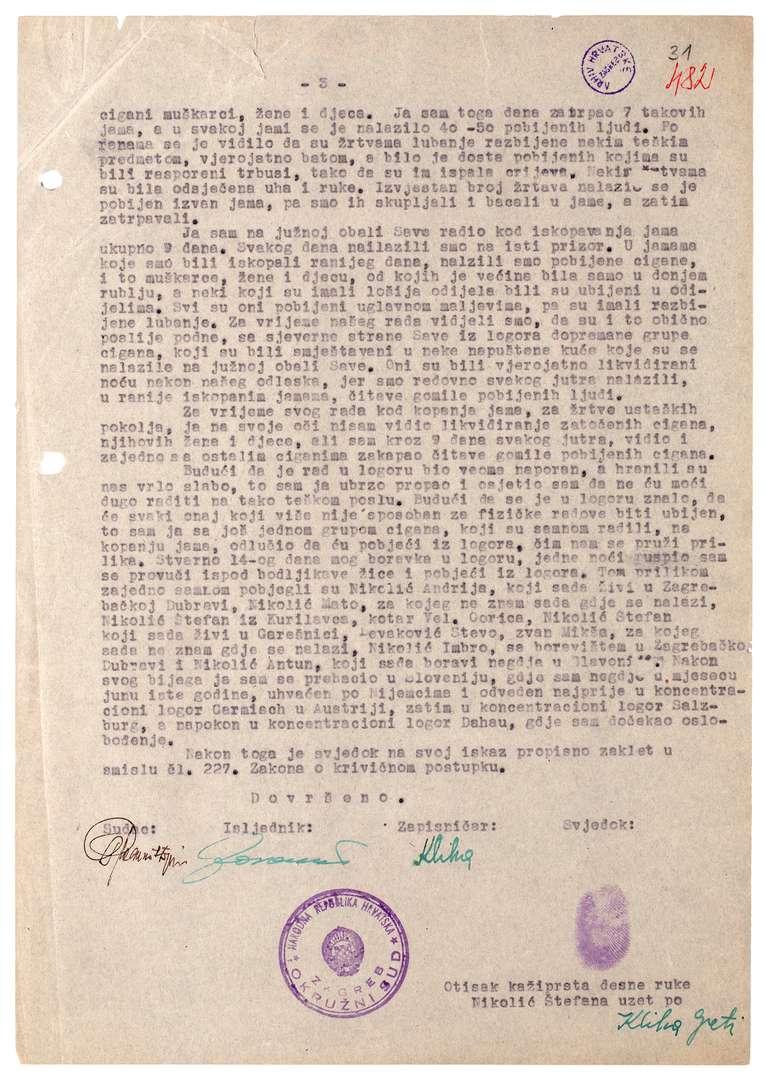ZAPISNIK
Sastavljen dana 14. marta 1952. godine kod Okružnog suda u Zagrebu povodom preslušavanja svjedoka NIKOLIĆ ŠTEFANA u krivičnom predmetu protiv Artuković dr. Andrije zbog krivičnih djela iz čl. 124., 125. i 128. Krivičnog zakona.
Prisutni: Premuž Stjepan, sudac Okružnog suda u Zagrebu
Jovanović Željko, isljednik
Klika Greta, zapisničar
Svjedok NIKOLIĆ ŠTEFAN, sin Štefana radnik iz Zagrebačke Dubrave, rodjen 11.XII. 1918. u Bistri, nepismen, nije kažnjavan.
Nakon što je utvrdjena istovjetnost svjedoka Nikolić Štefana, te nakon što je u smislu čl. 168 Zakona o krivičnom postupku opomenut na dužnost kazivanja istine, upoznat s predmetom svjedočenja iskazuje:
Ja sam porijeklom ciganin. Od god. 1937. pa do polovine mjeseca maja 1942 ja sam sa svojom porodicom živio u Zagrebačkoj Dubravi zaradjujući svoj svakodnevni kruh prevoženjem, jer sam imao svoje konje i kola. Imao sam ženu Nikolić Šteficu staru 20 godina,i jedno dijete Danicu, staru 3 godine. U času kad smo po policijskim organima tzv. Nezavisne Države Hrvatske bili odvedeni u koncentracioni logor Jasenovac moja žena nalazila se je u IX. mjesecu trudnoće i trebala je kroz tri tjedna roditi.
Kako sam spomenuo polovinom mjeseca maja 1942. došlo su u Zagrebačku dubravu, gdje se je nalazilo čitavo cigansko naselje, policijski organi tzv. Nezavisne Države Hrvatske i ustaše, te su nam rekli da smjesta moramo napustiti svoje domove i da ćemo svi bez razlike biti otpremljeni nekuda u Bosnu, gdje ćemo biti na prisilnom radu, i raditi na nekim napuštenim posjedima. Stvarno su svi cigani iz spomenutog naselja sa svojim stvarima prepraćeni na tzv. sajmište u Zagrebu, gdje smo bili utovareni u 4 marvinska vagona i u tim vagonima ostali smo zatvoreni 2 dana, a nakon toga smo krenuli vlakom u pravcu Istoka.
Trećeg dana negdje oko 11 sati prije podne naši su vagoni bili odkopčani pred koncentracionom logoru Jasenovac. U vagonima smo bili zatvoreni oko 2 sata i kroz prozorčiće smo razgledavali okolinu. Na jednoj poljani primijetio sam čitavu gomilu razbacanih kola, za koju sam zaključio da su bila vlasništvo cigana, obzirom na poseban tip kola koje su cigani običavali izradjivati. Takodjer sam vidio da se je nekoliko grupa cigana kretalo mimo nas pored Save, a za svakom grupom na jednim kolima vozili su se ustaše, a u kolima su se nalazili krampovi, lopate i željezni batovi. U svakoj grupi nalazili se je 40 – 50 muškaraca, žene i djece, a sve su to bili cigani. Vidio sam da su neki ljudi iz tih grupa okajali i zapomagali. Iz jedne grupe bila je jedna starica pala na zemlju, vjerojatno je bila iscrpljena, pa je tada k njoj pristupio jedan ustaša, istrgao joj iz ruku njezin štap i tim štapom je počeo nemilosrdno lupati po glavi, a nakon toga joj je užetom svezao ruke i odvukao do obale Save odakle ju je bacio u vodu. Slična stvar ponovila se sa jednom ženom iz jedne od idućih grupa. Koliko se sjećam, ukupno je bilo prošlo pokraj nas 5 takovih grupa. Nakon toga nama su ustaše počele zabranjivati da gledamo kroz prozorčiće kamenjem. Nakon prolaska tih, otprilike pola sata kasnije, vidjeli smo iz protivnog pravca dolaziti grupu od 20 – 30 ustaša od kojih su neki bili samo u košuljama, a drugi su imali ljetne bluze, medjutim svi su imali zasukane rukave i ruke su ime bile potpuno krvave, a krvlju su im bile poprskane i čizme. Nakon toga nam je postalo sve jasno, da smo prevareni, te da ćemo ovdje stradati. Kako sam rekao u vagonima smo nalazili oko 2 sata, nakon lega su nas istjerali iz vagona i morali smo u neke sanduke pobacati sve naše isprave, novac i predmete od vrijednosti. Ja sam zapitao nekoga ustašu, da li će se sastaviti popis o ovim stvarima, koje nam se oduzimaju, našto se je ovaj izderao neka ništa ne pitam. Bilo nam je rečeno, da će svaki onaj, koji zataji makar 25 para odmah biti ubijen. Na tu prijetnju mi smo u te sanduke pobacali sve stvari, pa čak i čikove i mrvice duhana koje su nam se nalazile po džepovima. Zatim su nas ponovno strpali u vagone i zatvorili. Poslije pola sata bili smo ponovno istjerani iz vagona i tu su svi mladji i jači i odporniji muškarci odvojeni, i odvedeni u jedan logor u kojem su se nalazile barake u kojima su stanovali zatočenici koji su u logoru radili fizičke poslove. Iz ova 4 vagona bilo nas je izabrano vrlo malo, najviše 10 muškaraca. Istog dana, poslije podne, oko 3 sata, muškarce, ženu i djecu, koji su ostali u vagonima, odveli su u jedan drugi logor koji se je nalazio u blizini. To je bio ograđeni bodljikavom žicom prostor otprilike 200 četvornih hvati velik, na kojem nije bilo nikakovih nastambi ili zgrada. Na tom prostoru nalazio se je veliki broj muškaraca, žene i djece, sve od reda cigani. U logoru u kojem sam se ja nalazio bilo je više hiljada ljudi, medju kojima je bilo židova, pravoslavaca i cigana. Budući da svi nisu mogli stati u barake, neki su spavali i vani. Budući da ja još uvijek nisam znao, kuda sam dopremljen, to sam se interesirao gdje se nalazim, našto su mi ljudi, koji su prije mene u taj logor bili dovedeni, rekli da bolje neka ništa ne pitam. Istoga ili drugoga dana, bio sam u tom radničkom logoru sreo svoje kumove Nikolić Janka i Antuna iz Pušće Bistre, koji su se u tom logoru nalazili već dva tjedna. Oni su bili toliko mršavi i obrašteni bradama, da ih ja nisam ni prepoznao. Oni su mi pričali da su već trebali biti pobijeni u tom logoru, pa da su već bili iskopali i jame u koje su trebali biti bačeni, medjutim da su ipak bili pošteđeni i poslani u grupu za vršenje teških fizičkih radova. Nikolić Janko mi je pričao, da s druge strane Save ustaše ubijaju cigane, te da je on zakopavao neke pobijene žrtve, a medju njima da je pronašao i svoju vlastitu ženu i djecu.
Drugog dana ujutro mi smo bili poslani radi kopanja nekog graha i radili smo sasvim u blizini ciganskog logora u kojem se je nalazila moja žena i djeca. Iz tog logora protekle noći bila je odvedena gotovo polovina zatočenika, koji su samnom bili došli prijašnjeg dana. Moja žena, koja me je primjetila, vikala mi je preko žice, da se boji za sudbinu svoju i svoje djece, a ja sam bio zamolio ustašu, koji nas je čuvao, da mi dozvoli da s njom časkom porazgovaram, što je ovaj odbio, rekavši mi da koliko sam sa ženom razgovarao, da je to sve, te da više s njom ne ću razgovarati. Istog dopodneva negdje oko 11 sati, u taj logor bila je ušla grupa ustaša koja je zapovjedila svim ciganima, da skinu gornje rublje, i cipele, pa su ih sasvim vezali žicom za ruke i to dvojicu ljudi zajedno, i odveli nekuda iz logora. Nakon toga, od njih se u taj logor nije više nitko povratio.
Idućeg dana vidio sam sa nasipa, jer se je logor nalazio kraj obale Save, na drugoj strani obale odprilike 150 – 200 metara udaljeno, kako su ustaše bacale u visu malu djecu i dočekivali ih na bajunete. Video sam da je na taj način ubijeno 6 ili 7 djece.
Petog dana ja sam sa jednom grupom cigana prebačen čamcem na južnu obalu Save i tu smo podijeljeni u 4 grupe, pa nam je bilo stavljeno u zadatak da kopamo u zemlji velike jame. Na rad nas je moglo biti ukupno oko 50 ljudi, a ove jame su bile od obale Save udaljene odprilike 200 metara. Jame su bile veličine odprilike 10 metara u kvadrad, a bile su gotovo još i nešto dublje. Svakog dana smo iskopali 4 takove jame, a radili smo od 7 sati izjutra pa do 16 sati poslije podne. Odmah prvoga dana ja sam sa jednom grupom cigana zatrpavao ranije iskopane jame. U tim jamama nalazili su se pobijeni cigani muškarci, žene i djeca. Ja sam tog dana zatrpao 7 takovih jama, a u svakoj jami se je nalazilo 40 – 50 pobijenih ljudi. Po ranama se je vidilo da su žrtvama lubanje razbijene nekim teškim predmetom, vjerojatno batom, a bilo je dosta pobijenih kojima su bili rasporeni trbusi, tako da su im ispala crijeva. Nekim žrtvama su bila odsječena uha i ruke. Izvjestan broj žrtava nalazio se je pobijen izvan jama, pa smo ih skupljali i bacali u jame, a zatim zatrpavali.
Ja sam na južnoj obali Save rado kod iskopavanja jama ukupno 9 dana. Svakoga dana nailazili smo na isti prizor. U jamama koje smo bili iskopali ranijeg dana, nalazili samo pobijene cigane, i to muškarce, žene i djecu, od koji je većina bila samo u donjem rublju, a neki koji su imali lošija odijela bili su ubijeni u odijelima. Svi su oni pobijeni uglavnom maljevima, pa su imali razbijene lubanje. Za vrijeme našeg rada vidjeli smo, da su i to obično poslije podne, sa sjeverne strane Save iz logora dopremane grupe cigana, koji su bili smještovani u neke napuštene kuće koje su se nalazile na južnoj obali Save. Oni su bili vjerojatno likvidirani noću nakon našeg odlaska, jer smo redovno svakog jutra nalazili, u ranije iskopanim jamama, čitave gomile pobijenih ljudi.
Za vrijeme svog rada kod kopanja jama, za žrtve ustaških pokolja, ja na svoje oči nisam vidio likvidiranje zatočenih cigana, njihovih žena i djece, ali sam kroz 9 dana svakog jutra, vidio i zajedno s ostalim ciganima zakapao čitave gomile ubijenih cigana.
Budući da je rad u logoru bio veoma naporan, a hranili su nas vrlo slabo, to sam ja ubrzo propao i osjetio sam da ne ću moći dugo raditi na tako teškom poslu. Budući da se je u logoru znalo, da će svaki onaj koji više nije sposoban za fizičke poslove biti ubijen, to sam ja s još jednom grupom cigana, koji su samnom radili, na kopanju jama, odlučio da ću pobjeći iz logora, čim nam se pruži prilika. Stvarno 14-og dana mog boravka u logoru, jedne noći uspio sam se provući ispod bodljikave žice i pobjeći iz logora. Tom prilikom zajedno samnom pobjegli su Nikolić Andrija, koji sada živi u Zagrebačkoj Dubravi, Nikolić Mato, za kojeg neznam sada gdje se nalazi, Nikolić Štefan iz Kurilavca, kot. Vel. Gorica, Nikolić Štefan koji sada živi u Garešnici, Levaković Stevo, zvan Mikša, za kojeg sada neznam gdje se nalazi, Nikolić Imbro, sa boravištem u Zagrebačkoj Dubravi i Nikolić Antun, koji sada boravi negdje u Slavoniji. Nakon svog bijega ja sam se prebacio u Sloveniju, gdje sam negdje u mjesecu junu iste godine, uhvaćen po Nijemcima i doveden najprije u koncentracioni logor Garmisch u Austriji, zatim u koncentracioni logor Salzburg, a napokon u koncentracioni logor Dahau, gdje sam dočekao oslobođenje.
Nakon toga je svjedok na svoj iskaz propisno zaklet u smislu čl. 227. Zakona o krivičnom postupku.
DOVRŠENO
Sudac:
[nečitko]
Iseljdnik:
[nečitko]
Zapisničar:
[nečitko]
Svjedok:
[nečitko]
[otisak prsta svjedoka Štefana Nikolića]
Otisak kažiprsta desne ruke Nikolić Štefana uzet od
Klika Greta











